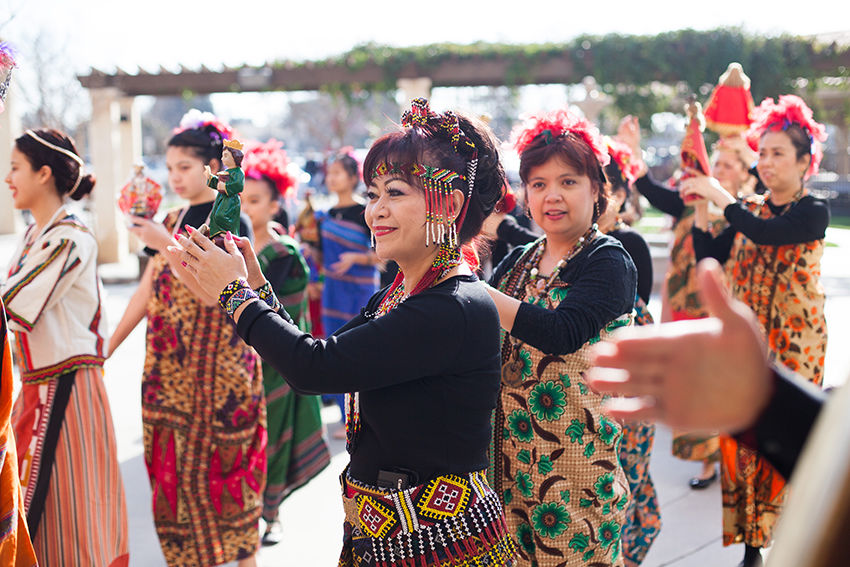Holy Name of Mary Church in San Dimas recently celebrated Santo Niño, a Filipino faith tradition honoring the Holy Child Jesus. The annual feast, which is celebrated on the third Sunday in January, is marked by fiesta, sinulog (dancing in the streets) and prayers offered to Santo Niño de Cebú, the oldest religious relic in the Philippines.
The image of Santo Niño de Cebú is venerated as miraculous by many Filipino Catholics.
Sponsored by the Filipino Catholic Ministry at Holy Name of Mary Parish, the Santo Niño celebration began with a colorful procession of liturgical dancers carrying different statues of the Holy Child Jesus. The dancers wore brightly colored traditional tribal costumes called T’poli with beaded headbands and necklaces.
Each bead on the handmade accessories told a story.
“Each bead can be a story of birth, separation and continuation of life,” said Josefina Solomonson, president of the Filipino Catholic Ministry at Holy Name of Mary Parish.
During the Jan. 15 celebration at Holy Name of Mary, liturgical dancers gracefully danced around pews, swaying side-to-side with their statues, moving rhythmically to the beat of drums. The joyful sinulog procession showed devotion to God.
The vibrant procession ended after the dancers and members of the parish community placed their Santo Niño statues on the steps of the altar.
The largest statue on the altar was donated to the parish by Ofelia Ochoco, who had it handcrafted in the Philippines. The foot-tall statue mirrored the original Holy Child of Cebú, which depicts Child Jesus as a king dressed like Spanish royalty. Other Santo Niño statues were smaller and each one was dressed differently, highlighting God’s love and mercy for all people.
“Each Santo Niño is a beautiful image of the diversity of the God that has created us,” explained Father Rich Danyluk, SS.CC, of Holy Name of Mary.
Father Danyluk, whose native tongue is not Tagalog, read the Gospel in Tagalog. During the homily, he talked about how each of the images are different, but noted there is not one “right” one. He emphasized the fact that Jesus is present in everyone.
The Filipino Catholic Ministry collaborated with Holy Name of Mary School and St. Joseph School in Pomona to put together the Santo Niño celebration.
“I asked the students if they wanted to participate in Santo Niño, to experience the culture and learn its history, to be proud of it,” said Solomonson.
Seven junior high students and three alumni from St. Joseph’s School participated in the Vessels of Mary Liturgical Dance Group, which led the sinulog procession. Schoolchildren from Holy Name of Mary sang songs during Mass.
“I’ve never experienced the Santo Niño before. Holy Name of Mary is a very welcoming and embracing parish. The celebration was very colorful,” said Claudia Godlewski, principal of St. Joseph’s School.
Godlewski’s own baby, Joseph, was a Santo Niño in the dance procession.
Santo Niño has been celebrated for more than 15 years at Holy Name of Mary. The joyful devotion is symbolic to all Catholics to approach faith with wonder and awe, like that of a child.
“The culture of the Filipino’s have enriched our lives,” said Father Danyluk.
After the Mass, the community was invited to lunch provided by the Filipino Catholic Ministry.
The history of Santo Niño de Cebú
In 1521, Portuguese explorer Ferdinand Magellan planted the cross on the shores of Cebú, Philippines, claiming territory for Spain. Magellan gave the Holy Child statue as a gift to Rahah Human, who was the ruler of the island. Rahah was later baptized and named Carlos after the King of Spain, Charles V. His wife, Hara Humamay, took the name Juana after Joanna of Castille, mother of Charles V. At this time, more than 800 natives were baptized in the Roman Catholic Church.
At the moment of receiving the image of the Holy Child, it was said that Queen Juana danced with joy. Natives followed her example and began dancing, too. This moment is regarded as the first sinulog honoring the Santo Niño.
Filipinos regard the image of Santo Niño de Cebú as miraculous because it survived a fire that burnt down the coastal town in 1565. Originally, the feast of Santo Niño was celebrated on April 28. Due to conflicts with Easter time, the date of the feast was later moved to January.
Locally, Santo Niño celebrations are held throughout the archdiocese, including at the Cathedral of Our Lady of the Angels in Downtown Los Angeles. The Vessel of Mary Liturgical and Cultural Dance Group presented another sinulog at St. Finbar Church in Burbank on Jan. 21, and that same day St. Elizabeth Ann Seton in Rowland Heights hosted a Santo Niño Mass celebrated by Bishop Joseph V. Brennan. St. John’s Seminary in Camarillo will also host a Santo Niño Mass at 11 a.m. on Jan. 29.
Interested in more? Subscribe to Angelus News to get daily articles sent to your inbox.

